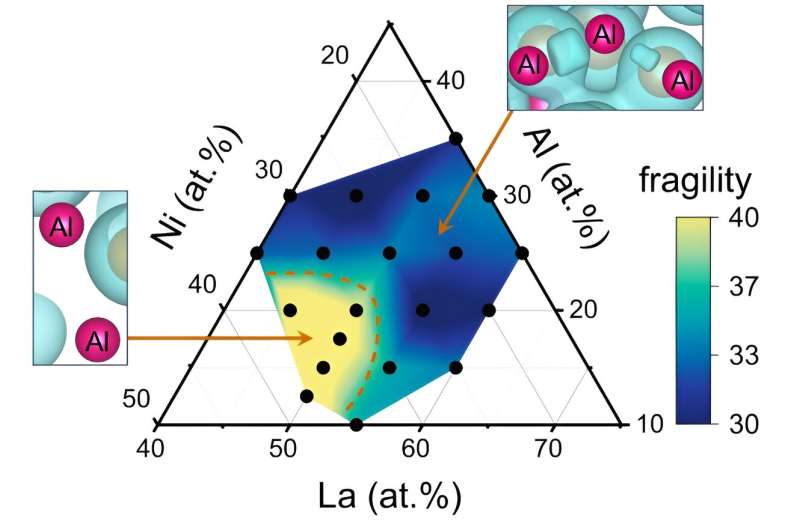This article has been reviewed according to Science X's editorial process and policies. Editors have highlighted the following attributes while ensuring the content's credibility:
fact-checked
proofread
Fragility crossover mediated by covalent-like electronic interactions in metallic liquids

In the field of glass and liquid sciences, the so-called fragility is a key concept that characterizes how rapidly the liquid dynamics showdown on lowering the temperature. However, a long-standing challenge is that the occurrence of crystallization hinders the evaluation of fragility in glass-forming materials.
A team of researchers has pushed the boundaries of traditional techniques and successfully gathered crossover data on fragility for various alloy families. They have proposed the underlying origins of fragility in metallic glass (MG) from an electronic structure standpoint and provided insights for material design.
Typically, the fragility of liquids is determined by measuring the viscosity of the liquid at different temperatures. However, a combination of techniques is often necessary to cover the entire viscosity range. Alternatively, the fragility can also be estimated by differential scanning calorimetry (DSC) from its glassy state.
Nonetheless, challenges such as crystallization interference, limited heating rates of DSC, and thermal history hinder the accurate determination of fragility across various composition ranges. Therefore, the key question here is how to measure fragility across a broad spectrum of compositions effectively.
A team of Chinese scientists has now used rapid calorimetric analysis to acquire precise composition-dependent fragility data in the La-Ni-Al and Cu-Zr-Al metallic glass systems. Intriguingly, their findings revealed a subtle composition-dependent trend in fragility: at a certain point, a slight increase in the Al content led to a significant decrease in the fragility value, exhibiting a sudden jump or crossover behavior.
The researchers employed a combination of techniques, including X-ray photoelectron spectroscopy, resistance measurements, electronic structure calculations, and DFT-based deep-learning atomic simulations, to explore the underlying mechanism of this fragility crossover.
Their analysis suggested that the reduction in fragility could be linked to the formation of covalent-like bonding between Al-Al interactions triggered by the introduction of additional aluminum. Thus, they have eventually discovered what controls liquid fragility in metallic liquids.
The ultrafast calorimetric analysis will be able to provide a more comprehensive fragility database. Based on the fragility data and the electronic structure perspective, more diverse amorphous materials will be designed.
These findings provide insight into the origin of fragility in metallic liquids from an electronic structure perspective and pave a new way for the design of metallic glasses.
The research has been recently published in Materials Futures.
More information: Hui-Ru Zhang et al, Fragility crossover mediated by covalent-like electronic interactions in metallic liquids, Materials Futures (2024). DOI: 10.1088/2752-5724/ad4404
Provided by Songshan Lake Materials Laboratory

















